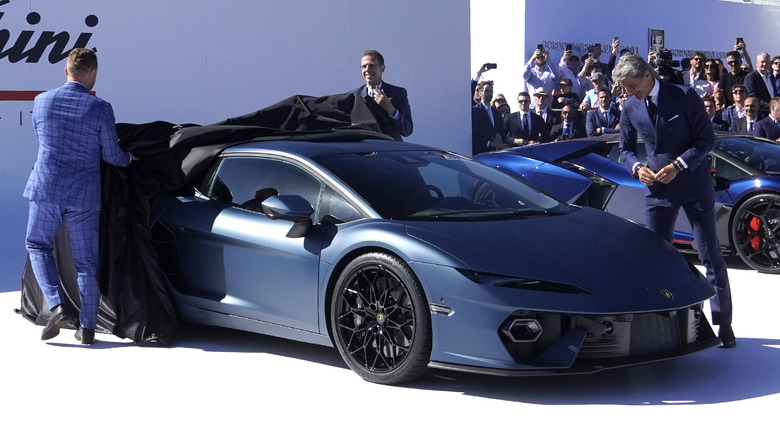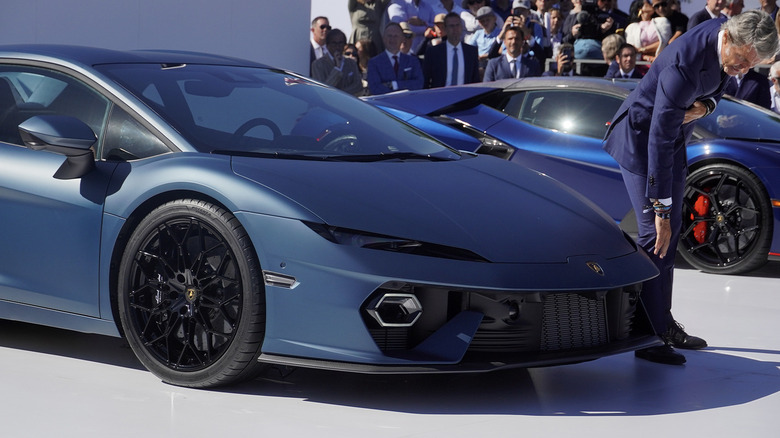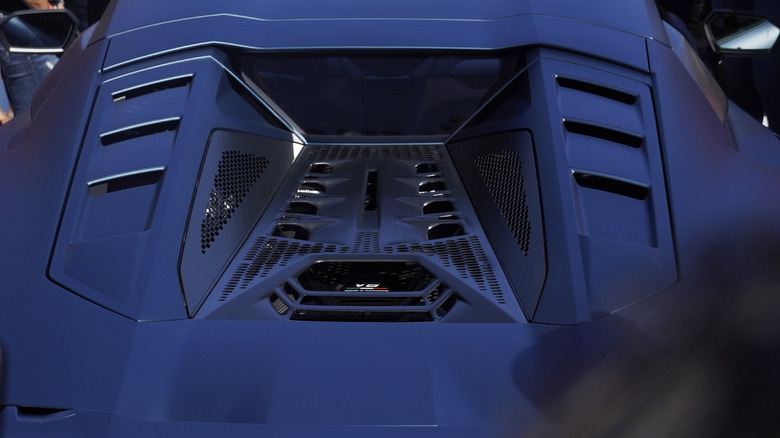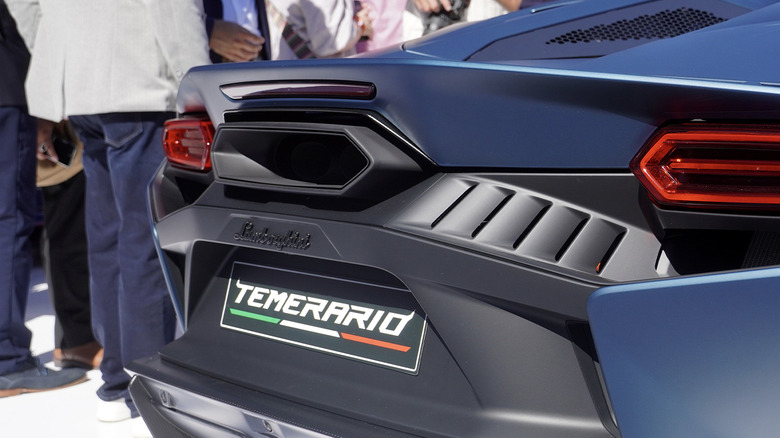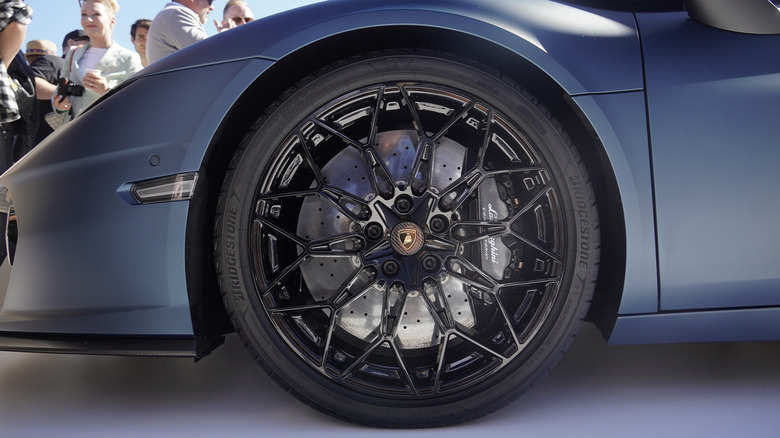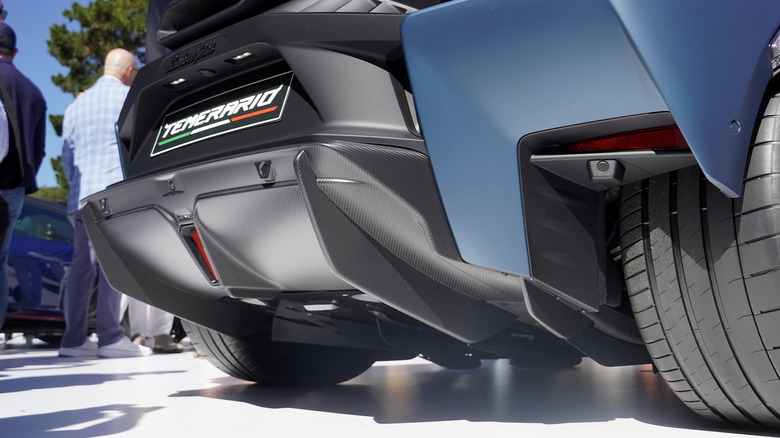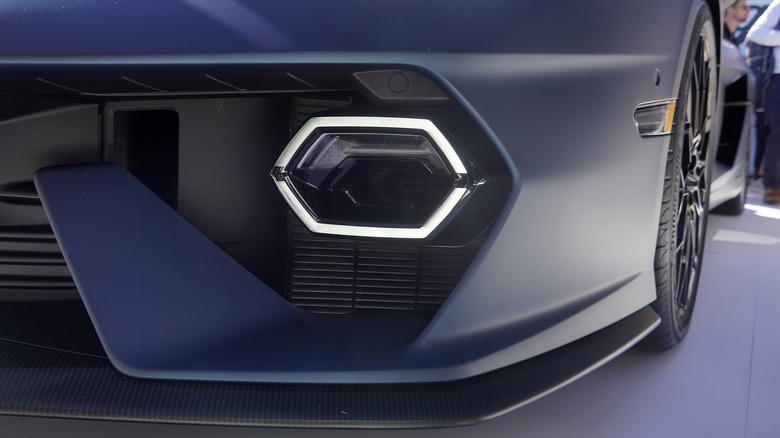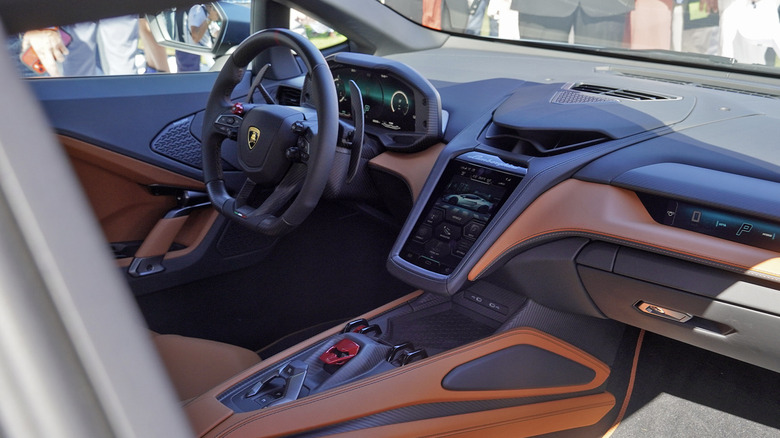Lamborghini Temerario First Look: How Huracan's Hybrid Replacement Does The Astonishing
Today, at Monterey Car Week's swankiest event, the Lamborghini Huracan finally received a fitting successor. The immaculate golf course of The Quail, A Motorsport Gathering provided the perfect setting for the Italian automaker to unveil a ground-breaking hybrid supercar with unbelievable power levels on tap from a screaming twin-turbocharged V8 engine.
We already knew many of the powertrain details, but now the world can see the 634, as Lambo's previous teases called the car. And the announcement also revealed the official model name, Temerario, a brave bull that CEO Stephan Winkelmann claims fought in Madrid in 1875.
Lambo's ad campaign for the Temerario will focus on personal expression with the phrase "You can't hide who you are," yet the temerity of developing such a bold Huracan successor stands somewhat in contrast with a more staid exterior design. Themes from the V12-powered Revuelto plug-in hybrid carryover, with smoother lines and fewer extraneous details to break up the profile.
Smoother style for a classy hybrid
The Temerario adds 40 millimeters (1.57 inches) to the Huracan's wheelbase to squeeze in that twin-turbo V8, a battery pack, and three electric motors. Yet the car still remains much smaller than the Revuelto at 273 millimeters (10.7 inches) less in overall length. Almost more importantly, the lack of light bars and LED strips in favor of hexagonal shapes throughout helps to emphasize the compact nature of this smaller super sports car.
The razor-sharp front end features daytime running lights that double as air intakes, and the upper rear haunches run almost flat with intake ducts that border on NACA style. To my eye, the Temerario almost looks a little taller than the Huracan, though I'd need to check the official stats whenever Lambo reveals every last detail. Perhaps the larger 20 and 21-inch wheels, now available with a full carbon-fiber option, provide a stance that creates something of an optical illusion.
A slightly taller roof might help to increase interior roominess, something that also follows the Revuelto's lead. And the overall interior looks very familiar after my time with a Revuelto, from the steering wheel to the floating center console screen and switchgear, all the way over to the passenger touchscreen. Of course, customization options available through Lambo's Ad Personam department will make a big difference in spec and style, and Winkelmann explained that the Temerario will launch with over 400 colors available from the jump.
An evolutionary leap more than a jump
Even if the new car's styling clearly takes something of an evolutionary step, really the Temerario's powertrain tech represents a much larger leap that from Gallardo to Huracan. Those two predecessors, so closely related to Audi's R8, slowly improved over the years. But the Temerario takes power and performance to a whole new level, so I quizzed Chief Technical Officer Rouven Mohr the night before the debut about how the hybrid system works, and how he established a new ethos while developing such a radical new drivetrain.
I started off by asking whether he had driven Porsche's new 911, which might have provided some inspiration for Lambo's development of the Revuelto's little sibling.
"At the moment, I have not yet driven the 911 GTS T-hybrid concept," Mohr replied. "But I have to say I like it also. But the mission of the hybrid system is a different one because we use, in the Temerario, the hybrid system for a lot of things that would not be possible with the Porsche system."
"The Porsche system is for sure focused much more on weight saving," he continued. "We wanted to go to this super high performance level. Therefore, to be honest, we needed classical turbochargers to achieve this kind of power at 9,000 and then up to the 10,000 revs. And we use also electric power for the torque vectoring and this would be also not be possible. Therefore, you cannot compare the concepts. I think our concept is the right one for our mission."
How a twin-turbo V8 can rev so high
The prospect of a twin-turbocharged V8 that revs higher than the Revuelto's V12 blew my mind when the engine first broke cover last year. But the total output now also borders on Revuelto level, as today Lambo stepped up to report an even higher combined rating of 907 horsepower. The gas engine alone puts out 800 of those ponies, thanks to massive turbos that push up to 36.2 PSI of boost while the electric motors compensate for lower end shove. But how on earth can a turbocharged V8 support such stratospheric revving, I wondered.
"The enabler is the flat crankshaft," Mohr confirmed. "But the ratio between bore and stroke is very important. And you have to lighten all the things like the titanium con-rods. The second thing you have to do, and this is the most critical one, is to find a solution for your valvetrain."
"On this, we decided to use a standard finger-follower in a very stiff way. So we have a two-part cylinder head and the upper part, like in a race engine, is only the bracket. It's the carrier of the valvetrain to allow really stiff conditions together with a finger-follower."
Part of the challenge in developing an engine that revs so high involved maintenance concerns. Racing tech like finger-followers that can withstand up to 11,000 revs, for longevity's sake, required extra attention.
"You have to manage the mass of the valves, the stiffness of the springs, and the big challenge is to do something does not have a huge maintenance effort," Mohr explained. "You have to do it in a very smart way because the engine has a lifetime of maintenance. It's not that you get to make an adjustment of the valvetrain after some miles, you have to find a way to manage the actuation of the valvetrains."
On an display engine stand, Mohr pointed out some of the cams and gear locations, as well as a very short chain that controls the valvetrain. But using too many gears also creates too much noise for Lambo's luxury buyers, he said. And the vibrations from so much mass rotating so quickly requires even special connectors for accessories including the fuel pump, dry sump oiling system, and even the cam phasers.
Hybrid power for performance, not range
Meanwhile, the Temerario's hybrid system that complements such an impressive internal-combustion engine also differs slightly from the Revuelto. A 3.6-kWh battery and three electric motors might sound identical, but the Revuelto housed a motor in the transaxle while the Temerario uses a more typical P1 location between the engine and gearbox, connected to the crankshaft instead. This single axial flux unit (versus the Revuelto's radial flux motor) can put out 148 horsepower and 221 lb-ft of torque, while the two front motors help raise the total torque output to 442 lb-ft available from idle.
The system will start out in silent electric mode, to keep neighbors happy, yet maximizing range never fit into the equation. Instead, Mohr believes that in addition to all-out acceleration stats, the e-motors allow for novel use of torque vectoring programs to improve traction while braking, cornering, and accelerating alike. I recalled driving the Revuelto around Vallelunga circuit in Italy and marveling at how light a nearly 4,000-pound hybrid seemed through tighter corners than expected. Would the Temerario use similar strategies, given the slightly lower curb weight of 3,725.8 pounds?
"So, the basic functionalities on the front axle are the same," Mohr told me, "But the situation and the magnitude and the level, how much we use it, is completely different compared to the Revuelto. In this car, it depends a little bit on the driving mode, but in general, from the percentage point of view, we use a little bit more the rear axle. Since the wheelbase is shorter, in some cases, we use it also a little bit more for the stabilization."
Hoping for turbo noises
That curb weight tacks on about 20% versus most Huracan variants, but if the Revuelto serves as any indicator, hopefully the Temerario can use the torque vectoring well enough to render any concerns about weight management entirely moot. And in fact, the all-new aluminum space frame increases torsional rigidity by 24% while still weighing less than the Huracan's chassis. Meanwhile the interior expands to allow 46 more millimeters of legroom and 34 millimeters of headroom, plus a small parcel shelf behind the seats and even a bigger frunk for luggage storage.
The additional space depends on the packaging of the engine, which uses a "hot V" arrangement with the exhaust and turbos between and above the cylinder banks. This creates the shortest physical length from exhaust to turbine, but I also asked Mohr if he purposefully wanted the driver to hear more turbo noises from this new Lambo.
"For sure, we have some turbo features," he replied, "but not super dominant because we wanted to generate from the sound environment, let me say, a pure and completely different experience. So if you hear the engine, first of all, it's more on the naturally aspirated side. But if you let off throttle at the low or mid-rev regions, you hear a little bit of turbo drama. But the basic character is more on the natural aspirated side."
Behind the hot V sits the P1 e-motor and then a transverse transaxle, which Lambo programmed to offer a wider operating range of smoother shifts in the Temerario's Citta and Strada modes, then snappier performance in Sport and Corsa. Almost as important, the transaxle's location allows for minimal overhang behind the rear tires, as well as a steeper and earlier diffuser angle. In total, the aerodynamics improve to create 103 percent more rear downforce versus the Huracan, and a 30% increase in cooling performance plus more brake cooling.
Hiding any Sterrato hopes and hints
Another benefit of the tri-motor hybrid system's torque vectoring, which Mohr had told me biases more to the rear axle than the Revuelto: For the first time, Lambo went whole hog and included a full-on drift mode. Of course, I had to ask if the inspiration for making that big step came from my favorite variant in the Huracan's lineup, the Sterrato.
"I'm always telling the story about our LDVI, about our dynamic control algorithm," Mohr laughed. "This car has, again, an evolutionary step, what we learned on the Sterrato is influencing the basic software, but if you ask me if the car drives a little bit like a Sterrato then I would say, no."
I made a face, not wanting to ask the obvious question. Mohr laughed more.
"Not because I don't like it, I mean, I still love the Sterrato, really. But never say never! It's not a forgotten the idea. At the moment, it's not planned, but we know that everyone in Lamborghini loved the concept. So let's see."
A Sterrato based on the Temerario may or may not materialize, but certainly not with the carbon-fiber wheel options that save up to 25 kilograms (55 pounds) when paired with the full Alleggerita package that Lambo revealed. This set of options represents the most hardcore possible aesthetic for the Temerario, at least for now, as downforce increases by an additional 67% without adding more drag.
A design for the next decade
But Lambo knows that some customers love wings, wings, wings as much as I love spraying dirt while sliding sideways in the Sterrato, and the Temerario needs to satisfy those buyers, too. So, even if nobody wants to discuss future plans, and Winkelmann emphasized that the hybrid Temerario's design needs to withstand the test of time for the next 10 years, the Alleggerita sort of sets a boundary on the more aggressive end for now.
If the response among my fellow journalists and the crowd at The Quail reveal anything, the Temerario's design hit the Lambo nail on the head. And knowing Mohr's wizardry with powertrain development and software programming, I sure hope this new hybrid drives as well as it looks. If so, the automaker can likely expect to continue ramping up production—with Revuelto orders already stacked up through 2026 and the hybrid Urus SE backlogged through 2025.
That Urus still represents 57% of total sales so far in 2024, a number that may well dip a bit as Revueltos continue to roll out and the final Huracans wrap up the end of an era. But Lamborghini clearly will leave Monterey hoping that the Temerario's new styling and crazy powertrain will help to further boost profile and positioning against the competition.
